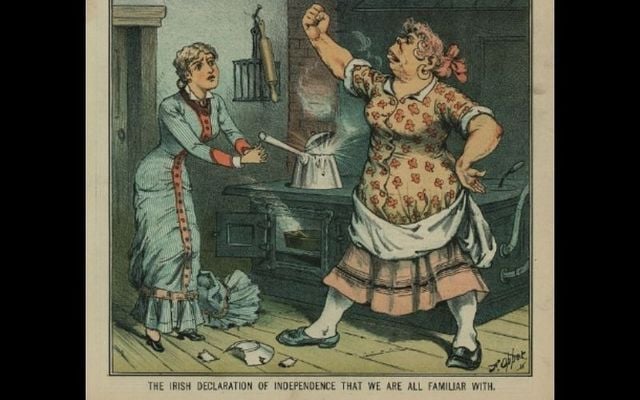Unflattering Bridget caricatures regularly appeared in national newspapers, stereotyping working-class Irish maids as incompetent and liable to cause havoc in middle-class homes.
Cartoons frequently depicted Bridgets as sub-human, toothless, and brutish women, somewhere between a man and a woman and between a human and an ape.
The social stigma faced by Irish immigrants and Irish women, in particular, was driven largely by nativists, who feared the significant influx of Irish Catholics in the United States.
Bridgets were the butt of music hall jokes and were subjected to prejudice and racism even from other maids.
In a letter to the New York Times in 1895, one such maid lamented the fact that Irish immigrants had infiltrated the domestic service profession.
The woman described Irish women as "the dirtiest and most grossly ignorant people" and called on then-President Grover Cleveland to annex Hawaii, charter several steamers, and send all Irish maids to the island on St. Patrick's Day where they could "fight amongst themselves until they were exterminated".
The anonymous author's sentiment was shared by Little Women author Louisa May Alcott, who penned a long article in the Boston Transcript in 1874 entitled "the servant girl problem".
"For several years, Irish incapables have reigned in our kitchen and general discomfort has pervaded the house," Alcott wrote.
She said her most recent Irish servant had been "unusually intelligent" but added that "the faults of her race seemed to be unconquerable".
"The winter had been a most trying one all around. My first edict was 'Biddy must go'."
Alcott said half a dozen Irish girls applied to replace the maid.
Her reply? "No Irish need apply".

Love Irish history? Share your favorite stories with other history buffs in the IrishCentral History Facebook group.
Unlike most other female immigrants, Irish women often traveled alone without a husband or a family, while more Irish women emigrated in the 19th century and early 20th century than men.
At an average age of 21, they were significantly younger than other immigrants.
The majority of Irish women flocked to domestic service jobs on the East Coast, with a whopping 94.5% of employed Irish women living in Kingston, New York, in 1860 employed as domestic servants.
The fact that they spoke English and likely had experience in similar jobs back home made them ideal fits for the role. The profession was also the preferred choice for many Irish women because it offered a relatively good salary and covered most living expenses, allowing workers to save money and chase the American dream.
"Despite the prejudice, many Irish women managed to pull themselves out of poverty and prosper in their adopted home," an RTÉ radio documentary said.
* Originally published in 2022, updated in Sept 2023.




Comments